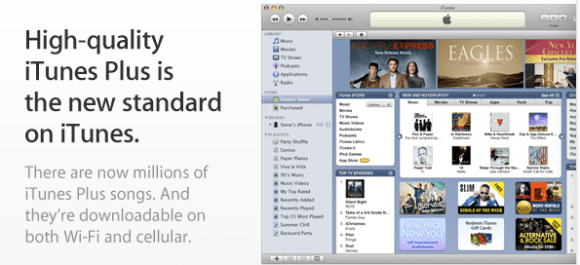 When most people make predictions for the coming year, they probably don’t expect them to come true six days in. But that’s the case with our 2009 prediction that iTunes would go DRM-free this year. Apple announced that its music store will lose its DRM at the Macworld Expo today. But in reality it was an easy prediction to make, because it just makes sense.
When most people make predictions for the coming year, they probably don’t expect them to come true six days in. But that’s the case with our 2009 prediction that iTunes would go DRM-free this year. Apple announced that its music store will lose its DRM at the Macworld Expo today. But in reality it was an easy prediction to make, because it just makes sense.
Most of the major music labels had been withholding their DRM-free music (that is, music without copyright protection) from iTunes while giving it to competitors like Amazon MP3 because that was really their only leverage in gaining what they wanted from Apple: Variable pricing. After nearly six years of fixed $0.99 per track pricing in iTunes, Apple finally relented and set three pricing tiers for individual track sales: $0.69, $0.99 and $1.29.
Before everyone freaks out, Apple’s Phil Schiller promised there would be many more tracks available for $0.69 than for $1.29. But the $1.29 ones will undoubtedly be the most popular new music, which will annoy quite a few users. But remember that $0.99 isn’t the same as it was six years ago when iTunes launched. With inflation, $0.99 back then would be $1.17 today — closer to the $1.29 price point, as CNET pointed out yesterday in scooping this story.
This new pricing structure in iTunes will go into effect April 1, 2009.
AI Weekly
The must-read newsletter for AI and Big Data industry written by Khari Johnson, Kyle Wiggers, and Seth Colaner.
Included with VentureBeat Insider and VentureBeat VIP memberships.
While some didn’t think the presence of DRM in iTunes was a big deal, I have to disagree. While it may not be a big deal for people like me who own just about everything Apple, those who used iTunes in the past but perhaps bought a Zune (crazy, I know) wouldn’t be able to play any of those tracks on their new device. Even I ran into the issue a few times this past year when trying to do things like stream music from my computer to my Xbox 360. And also when trying to put music on the Android-powered G1 phone. Neither of those devices can play DRM-laced iTunes tracks.
Bigger picture, this may not be a big deal right now as Apple is dominating both the digital music sales and playback device sales. But in the future, what happens if Apple is no longer the maker of the dominant player? You’d hope there’d be an easy way to convert DRM tracks to non-DRM ones, but what incentive would Apple have in providing that — especially if it was no longer king?
For now, it is king, and in my mind this will keep it king for a long time. I will resume purchasing music on iTunes immediately now that it is DRM-free (known as “iTunes Plus”). Starting today, roughly 80 percent of iTunes will go DRM-free thanks to support from all the major music labels. And by the end of the first quarter of this year all of the music on iTunes will be DRM-free.
Apple chief executive Steve Jobs must be pleased that he finally made good on (and surpassed) his 2007 promise of DRM-free music on iTunes. No matter which way you look at it, it’s a good thing.
That being said, this news, alongside the relatively new Genius sidebar feature in iTunes, will definitely hurt at least one thing: My bank account.
VentureBeat's mission is to be a digital town square for technical decision-makers to gain knowledge about transformative enterprise technology and transact. Learn More